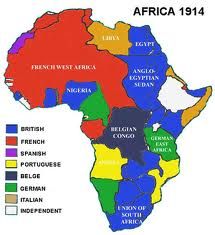Bretnea Turner
AP European History 🇪🇺
335 resourcesSee Units
New Imperialism vs. Old Imperialism
Old Imperialism of the 16th and 17th centuries focused mainly on “Gold, Glory and God” as the motivations for exploration. Stories of mythical cities of gold and promises of riches kept Europeans searching all over the world, mostly the Americas, tearing through native populations, and claiming land for their nations. This land was used for slave labor and the production of raw materials they couldn’t produce for themselves. However, this harsh lifestyle enforced by Europeans was lost to revolutions and revolts by natives and slaves.
New Imperialism focuses on the extension of a nation’s influence over another. Rather than “conquering” another nation, governments will seek to establish military bases, use colonies for cheap resources, and use their markets to sell manufactured goods. Most new imperialist endeavors focused on Asia, the Middle East, and Africa.

🎥 Watch: AP European History - 19th Century -isms
Motivations for New Imperialism
Economic
Old Imperialism focused on physical endeavors of establishing a colony they must maintain and control, or searching for riches. New Imperialism searched for cheap resources, crops, or labor in order to mass manufacture goods to then sell to their domestic and foreign markets. This created large profits for imperialist nations due to extremely low costs of production and guaranteed markets in which to sell. Europeans and Americans worked on maintaining control over strategic interests for resources, as well as responding to events involving Europeans or Americans around the world.
Religious
Protestant mission work became equal to Catholic mission work as Protestant faiths grew in Europe. The Catholic Church no longer dominated European politics and many nations under the control of Europeans were of different global religions. Europeans involved themselves in the Ottoman Empire to maintain “protection” over religious sites and peoples.
Government
Europeans had come to believe that having colonies was an important means of showing power. Old Imperialism required maintaining an area as a physical colony while New Imperialism focused on expanding influence over local governments, using colonies for military bases, establishing black markets in which to sell manufactured goods to take over the existing markets, building railroads, and the use of modern weaponry.
Imperialist tensions arose over the Eastern Question concerning the fate of the decaying Ottoman Empire also. European nations colonized or took control over territories formerly owned by the Ottomans or close to the Ottoman Empire to have influence over the area.
🎥 Watch: AP European History - Imperialism
Methods for New Imperialism
Free trade agreements allowed for European nations and America to introduce cheap or necessary goods into another country’s market that would cause a future demand for that good. Examples were vaccines, weapons, foods, textiles, and other manufactured goods. This demand allowed European and American governments to establish an economic influence over these countries to control and determine the terms of trade agreements.
The terminology “spheres of influence” was used to describe the direct or indirect involvement of a European nation or America in another nation’s politics, economy, religion, or society. Europeans and Americans would colonize a region or establish a protectorate in order to influence other aspects of life in that region or the areas around that region. A perfect example of this is a coined phrase “The sun never sets on the British Empire.” This is referring to the scope of the British sphere of influence and colonial holdings during the 19th century.
.jpg?alt=media&token=3c4fa9a6-550e-4815-90d0-cbc5837e0f2b)
Protectorates were established in non-Western territories by Europeans or Americans in order to protect their interests in that country. Interests were mostly economic or religious. The French established protectorates in Vietnam, Indochina, and the surrounding region. The British annexed India, and with the French, protectorates over Egypt and Tunisia. The United States annexed Hawaii and established a protectorate over the Philippines.
Browse Study Guides By Unit
🎨Unit 1 – Renaissance & Exploration
⛪️Unit 2 – Reformation
👑Unit 3 – Absolutism & Constitutionalism
🤔Unit 4 – Scientific, Philosophical, & Political Developments
🥖Unit 5 – Conflict, Crisis, & Reaction in the Late 18th Century
🚂Unit 6 – Industrialization & Its Effects
✊Unit 7 – 19th Century Perspectives & Political Developments
💣Unit 8 – 20th Century Global Conflicts
🥶Unit 9 – Cold War & Contemporary Europe
🚀Thematic Guides
📝Long Essay Questions (LEQ)
📆Big Reviews: Finals & Exam Prep

Fiveable
Resources
© 2023 Fiveable Inc. All rights reserved.